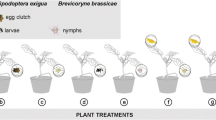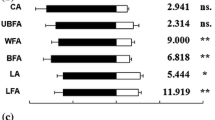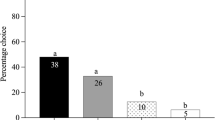Abstract
Parasitoids are known to exploit volatile cues emitted by plants after herbivore attack to locate their hosts. Feeding and oviposition of a polyphagous herbivore can induce the emission of odor blends that differ among distant plant species, and parasitoids have evolved an incredible ability to discriminate them and locate their hosts relying on olfactive cues. We evaluated the host searching behavior of the egg parasitoid Cosmocomoidea annulicornis (Ogloblin) (Hymenoptera: Mymaridae) in response to odors emitted by two taxonomically distant host plants, citrus and Johnson grass, after infestation by the sharpshooter Tapajosa rubromarginata (Signoret) (Hemiptera: Cicadellidae), vector of Citrus Variegated Chlorosis. Olfactory response of female parasitoids toward plants with no herbivore damage and plants with feeding damage, oviposition damage, and parasitized eggs was tested in a Y-tube olfactometer. In addition, volatiles released by the two host plant species constitutively and under herbivore attack were characterized. Females of C. annulicornis were able to detect and significantly preferred plants with host eggs, irrespectively of plant species. However, wasps were unable to discriminate between plants with healthy eggs and those with eggs previously parasitized by conspecifics. Analysis of plant volatiles induced after sharpshooter attack showed only two common volatiles between the two plant species, indole and β-caryophyllene. Our results suggest that this parasitoid wasp uses common chemical cues released by many different plants after herbivory at long range and, once on the plant, other more specific chemical cues could trigger the final decision to oviposit.


Similar content being viewed by others
References
Adams RP (2007) Identification of Essential Oil Components by Gas Chromatography/Quadrupole Mass Spectrometry, 4th edn. Allured Publishing Corporation, Illinois
Ali JG, Agrawal AA (2012) Specialist versus generalist insect herbivores and plant defense. Trends Plant Sci 17:293–302
Aquino MFS, Dias AM, Morges M, Blassioli-Moraes MC, Laumann RA (2012) Influence of visual cues on host searching and learning behaviour of the parasitoids Telenomus podisi and Trissolcus basalis. Entomol Exp Appl 145:162–174
Block AK, Hunter CT, Rering C, Christensen SA, Meagher RL (2018) Contrasting insect attraction and herbivore-induced plant volatile production in maize. Planta 248:105–116
Büchel K, Malskies S, Mayer M, Fenning TM, Gershenzon J, Hilker M, Meiners T (2011) How plants give early herbivore alert: volatile terpenoids attract parasitoids to egg-infested elms. Basic Appl Ecol 12:403–412
Clavijo McCormick AC, Unsicker SB, Gershenzon J (2012) The specificity of herbivore-induced plant volatiles in attracting herbivore enemies. Trends Plant Sci 17:303–310
Colazza S, Fucarino A, Peri E, Salerno G, Conti E, Bin F (2004a) Insect oviposition induces volatile emission in herbaceous plants that attracts egg parasitoids. J Exp Biol 207:47–53
Colazza S, McElfresh JS, Millar JG (2004b) Identification of volatile synomones, induced by Nezara viridula feeding and oviposition on bean spp., that attract the egg parasitoid Trissolcus basalis. J Chem Ecol 30:945–964
Colazza S, Peri E, Salerno G, Conti E (2009) Host searching by egg parasitoids: exploitation of host chemical cues. In: Consoli F, Parra J, Zucchi R (eds) Egg parasitoids in agroecosystems with emphasis on Trichogramma. Springer, Dordrecht, pp 97–147
Coletta-Filho HD, Castillo AI, Laranjeira FF, de Andrade EC, Silva NT, de Souza AA, Esteves Bossi M, Almeida RPP, Lops JRS (2020) Citrus variegated chlorosis: an overview of 30 years of research and disease management. Trop Plant Pathol 45:175–191
Coll Aráoz MV, Hill JG, Luft Albarracin E, Virla EG, Fernandez PC (2020) Modern Maize Hybrids Have Lost Volatile Bottom-Up and Top-Down Control of Dalbulus maidis, a Specialist Herbivore. J Chem Ecol 46:906–915
D’Alessandro M, Held M, Triponez Y, Turlings TC (2006) The role of indole and other shikimic acid derived maize volatiles in the attraction of two parasitic wasps. J Chem Ecol 32:2733–2748
De Moraes CM, Lewis WJ, Pare PW, Alborn HT, Tumlinson JH (1998) Herbivore-infested plants selectively attract parasitoids. Nature 393:570–573
De Moraes CM, Lewis WJ, Tumlinson JH (2000) Examining plant-parasitoid interactions in tritrophic systems. An Soc Entomol Bras 29:189–203
Degen T, Dillmann C, Marion-Poll F, Turlings TC (2004) High genetic variability of herbivore-induced volatile emission within a broad range of maize inbred lines. Plant Physiol 135:1928–1938
Degen T, Bakalovic N, Bergvinson D, Turlings TC (2012) Differential performance and parasitism of caterpillars on maize inbred lines with distinctly different herbivore-induced volatile emissions. PLoS ONE 7:e47589
Dellapé G (2013) Cicadelinos potenciales vectores de patógenos en cultivos citrícolas del NE argentino. Dissertation, Universidad Nacional de La Plata
Dellapé G, Paradell SL (2013) New records of Proconiini (Hemiptera: Cicadellidae) from Argentina. Rev Soc Entomol Argent 72:231–235
Dellapé G, Bouvet JP, Paradell SL (2013) Diversity of cicadomorpha (Hemiptera: Auchenorrhyncha) in citrus orchards in Northeastern Argentina. Fla Entomol 96:1125–1134
Dellapé G, Paradell S, Semorile L, Delfederico L (2016) Potential vectors of Xylella fastidiosa: a study of leafhoppers and treehoppers in citrus agroecosystems affected by Citrus Variegated Chlorosis. Entomol Exp Appl 161:92–103
Dexter E, Rollwagen-Bollens G, Bollens SM (2018) The trouble with stress: A flexible method for the evaluation of nonmetric multidimensional scaling. Limnol Oceanogr: Methods 16:434–443
Dicke M (1999) Are herbivore-induced plant volatiles reliable indicators of herbivore identity to foraging carnivorous arthropods?. In: Simpson SJ, Mordue AJ, Hardie J (eds) Proceedings of the 10th International Symposium on Insect-Plant Relationships. Springer, Dordrecht, pp 131–142
Erb M, Veyrat N, Robert CA, Xu H, Frey M, Ton J, Turlings TC (2015) Indole is an essential herbivore-induced volatile priming signal in maize. Nat commun 6:1–10
Esteves MB, Kleina HT, Sales TDM, Lopes JR (2020) Selection of host plants for vector transmission assays of citrus variegated chlorosis strains of Xylella fastidiosa subsp. pauca. Eur J Plant Pathol 158:975–985
Fatouros NE, Dicke M, Mumm R, Meiners T, Hilker M (2008) Foraging behavior of egg parasitoids exploiting chemical information. Behav Ecol 19:677–689
Fischbein D, Villacide JM, Lopez B, Corley JC, Martínez AS (2018) Host-related volatile cues used by a parasitoid wasp during foraging for its woodboring host. Entomol Exp Appl 166:907–913
Fischer S, Samietz J, Wäckers F, Dorn S (2001) Interaction of vibrational and visual cues in parasitoid host location. J Comp Physiol A 187:785–791
Freytag PH, Sharkey MJ (2002) A preliminary list of the leafhoppers (Homoptera: Cicadellidae) of Colombia. Biota Colomb 3:235–283
Giunti G, Canale A, Messing RH, Donati E, Stefanini C, Michaud JP, Benelli G (2015) Parasitoid learning: current knowledge and implications for biological control. Biol Control 90:208–219
Gols R, Bullock JM, Dicke M, Bukovinszky T, Harvey JA (2011) Smelling the wood from the trees: non-linear parasitoid responses to volatile attractants produced by wild and cultivated cabbage. J Chem Ecol 37:795–807
Gouinguené S, Degen T, Turlings TC (2001) Variability in herbivore-induced odour emissions among maize cultivars and their wild ancestors (teosinte). Chemoecology 11:9–16
Hofstetter RW, Raffa KF (1998) Endogenous and exogenous factors affecting parasitism of gypsy moth egg masses by Ooencyrtus kuvanae. Entomol Exp Appl 88:123–135
Huffaker A, Pearce G, Veyrat N, Erb M, Turlings TC, Sartor R, Shene Z, Briggse SP, Vaughana MM, Alborna HT, Teal PEA, Schmelz EA (2013) Plant elicitor peptides are conserved signals regulating direct and indirect antiherbivore defense. Proc Natl Acad Sci 110:5707–5712
Iacovone A, French AS, Tellier F, Cusumano A, Clément G, Gaertner C, Conti E, Salerno G, Marion-Poll F (2016) The role of contact chemoreception in the host location process of an egg parasitoid. J Insect Physiol 91:63–75
James DG (2005) Further field evaluation of synthetic herbivore-induced plan volatiles as attractants for beneficial insects. J Chem Ecol 31:481–495
Jofré N, Pildain MB, Cirigliano AM, Cabrera GM, Corley JC, Martínez AS (2016) Host selection by Ibalia leucospoides based on temporal variations of volatiles from the hosts’ fungal symbiont. J App Entomol 140:736–743
Jones WA, Logarzo GA, Virla EG, Luft E (2005) Environmental risk assessment of egg parasitoids from South America: nontarget field and laboratory host range in Argentina and the US. In: Tariq MA, Blincoe P, Mochel M, Oswalt S, Esser T (eds) Proceedings of the Pierce’s Disease Research Symposium. California Department of Food and Agriculture, San Diego, pp 343–344
Keil CB, Lozada PW (2021) Cicadellinae of Ecuador and Cicadellidae of Galápagos. Neotrop Biodivers 7:23–38
Keinan Y, Kishinevsky M, Segoli M, Keasar T, Keinan Y, Kishinevsky M, Segoli M, Keasar T (2012) (2012) Repeated probing of hosts: an important component of superparasitism. Behav Ecol 23: 1263–1268
Kollner TG, Held M, Lenk C, Hiltpold I, Turlings TC, Gershenzon J, Degenhardt J (2008) A maize (E)-β-caryophyllene synthase implicated in indirect defense responses against herbivores is not expressed in most American maize varieties. Plant Cell 20:482–494
Krugner R, Wallis CM, Walse SS (2014) Attraction of the egg parasitoid, Gonatocerus ashmeadi Girault (Hymenoptera: Mymaridae) to synthetic formulation of a (E)-β-ocimene and (E, E)-α-farnesene mixture. Biol Control 77:23–28
Logarzo GA, Virla E, Jones WA (2005) Egg parasitoids from Argentina, potential candidates for the biological control of glassy-winged sharpshooter in the United States. In: Hoddle MS (ed) Second International Symposium on Biological Control of Arthropods. Davos, Switzerland, pp 115–116
Loughrin JH, Manukian ARA, Heath RR, Turlings TC, Tumlinson JH (1994) Diurnal cycle of emission of induced volatile terpenoids by herbivore-injured cotton plant. Proc Natl Acad Sci 91:11836–11840
Manzano C, Benzal G, Logarzo GA, Coll Araoz MV, Virla EG, Luft Albarracin E (2021) Biological traits of Cosmocomoidea annulicornis (Hymenoptera: Mymaridae), an egg parasitoid of the sharpshooter Tapajosa rubromarginata (Hemiptera: Cicadellidae), a vector of Xylella fastidiosa in citrus orchards. Biol Control 157:104589
Michereff MFF, Borges M, Aquino MFS, Laumann RA, Gomes AM, Blassioli-Moraes MC (2016) The influence of volatile semiochemicals from stink bug eggs and oviposition-damaged plants on the foraging behaviour of the egg parasitoid Telenomus podisi. Bull Entomol Res 106:663–671
Mohammed K, Agarwal M, Li B, Newman J, Liu T, Ren Y (2020) Evaluation of D-Limonene and β-Ocimene as Attractants of Aphytis melinus (Hymenoptera: Aphelinidae), a Parasitoid of Aonidiella aurantii (Hemiptera: Diaspididae) on Citrus spp. Insects 11:44
Paradell SL, Virla EG, Logarzo GA, Dellapé G (2012) Proconiini Sharpshooters of Argentina, with notes on its distribution, host plants, and natural enemies. J Insect Sci 12:1–17
Paré PW, Tumlinson JH (1999) Plant volatiles as a defense against insect herbivores. Plant Physiol 121:325–332
Peñaflor MFGV, Erb M, Miranda LA, Werneburg AG, Bento JMS (2011) Herbivore-induced plant volatiles can serve as host location cues for a generalist and a specialist egg parasitoid. J Chem Ecol 37:1304–1313
Simpson M, Gurr GM, Simmons AT, Wratten SD, James DG, Leeson G, Nicol HI (2011) Insect attraction to synthetic herbivore-induced plant volatile‐treated field crops. Agric For Entomol 13:45–57
Takemoto H, Takabayashi J (2015) Parasitic wasps Aphidius ervi are more attracted to a blend of host-induced plant volatiles than to the independent compounds. J Chem Ecol 41:801–807
Tamiru A, Bruce TJ, Richter A, Woodcock CM, Midega CA, Degenhardt J, Kelemu S, Pickett JA, Khan ZR (2017) A maize landrace that emits defense volatiles in response to herbivore eggs possesses a strongly inducible terpene synthase gene. Ecol Evol 7:2835–2845
Triapitsyn SV, Huber JT, Logarzo GA, Berezovskiy VV, Aquino DA (2010) Review of Gonatocerus (Hymenoptera: Mymaridae) in the Neotropical region, with description of eleven new species. Zootaxa 2456:1–243
Turlings TCJ, Wäckers FL, Vet LEM, Lewis WJ, Tumlinson JH (1993) Learning of host-finding cues by hymenopterous parasitoids. In: Papaj DR, Lewis AC (eds) Insect Learning. Ecology and Evolutionary Perspectives. Chapman & Hall, New York, pp 51–78
Turlings TC, Loughrin JH, Mccall PJ, Röse US, Lewis WJ, Tumlinson JH (1995) How caterpillar-damaged plants protect themselves by attracting parasitic wasps. Proc Natl Acad Sci 92:4169–4174
Vet LE, Dicke M (1992) Ecology of infochemical use by natural enemies in a tritrophic context. Annu Rev Entomol 37:141–172
Virla EG, Logarzo GA, Paradell SL, Triapitsyn SV (2008) Bionomics of Oncometopia tucumana (Hemiptera: Cicadellidae), a sharpshooter from Argentina, with notes on its distribution, host plants, and egg parasitoids. Fla Entomol 91:55–62
Virla EG, Van Nieuwenhove GA, Palottini F, Triapitsyn SV, Logarzo GA (2019) Spatial and seasonal distribution of egg parasitoids of the sharpshooter Tapajosa rubromarginata (Hemiptera: Cicadellidae: Proconiini) on feral Johnson grass and commercial citrus host in Argentina. Biol Control 132:81–88
Virla EG, Aguirre MB, Van Nieuwenhove GA, Luft Albarracin EB, Logarzo GA (2020) The relationship among host plant species, egg clutch size, and level of parasitism for the sharpshooter Tapajosa rubromarginata. Entomol Exp Appl 168:900–910
Weber CA, Smilanick JM, Ehler LE, Zalom FG (1996) Ovipositional behavior and host discrimination in three scelionid egg parasitoids of stink bugs. Biol Control 6:245–252
Ye M, Veyrat N, Xu H, Hu L, Turlings TC, Erb M (2018) An herbivore-induced plant volatile reduces parasitoid attraction by changing the smell of caterpillars. Sci Adv 4:eaar4767
Zhou Y, Abram PK, Boivin G, Brodeur J (2014) Increasing host age does not have the expected negative effects on the fitness parameters of an egg parasitoid. Entomol Exp App 151:106–111
Zhuang X, Fiesselmann A, Zhao N, Chen H, Frey M, Chen F (2012) Biosynthesis and emission of insect herbivory-induced volatile indole in rice. Phytochemistry 73:15–22
Acknowledgements
This work was supported by PICT 2015 1147 and PICT 2019 1309 (FONCYT, Fondo para la Investigación Científica y Tecnológica, Argentina). We would like to thank “Vivero Lules” for providing the citrus plants used in all assays. Carolina Manzano thanks CONICET (Consejo Nacional de Investigaciones Científicas y Técnicas, Argentina) for the scholarship granted.
Funding
This work was supported by PICT 2015 1147 and PICT 2019 1309 (FONCYT, Fondo para la Investigación Científica y Tecnológica, Argentina).
Author information
Authors and Affiliations
Contributions
All authors contributed to the study’s conception and design. CM and MVCA wrote the manuscript. CM and PCF carried out the experiments. CM and JGH conducted insect field collections and statistical analyses. ELA, EGV, MVCA, and PCF supervised the project, revised the manuscript, and secured funding. All authors helped shape the research, analysis and approved the manuscript.
Corresponding author
Ethics declarations
Conflict of interest
The authors declare that they do not have any conflict of interest associated with this work.
Additional information
Publisher’s Note
Springer Nature remains neutral with regard to jurisdictional claims in published maps and institutional affiliations.
Rights and permissions
Springer Nature or its licensor holds exclusive rights to this article under a publishing agreement with the author(s) or other rightsholder(s); author self-archiving of the accepted manuscript version of this article is solely governed by the terms of such publishing agreement and applicable law.
About this article
Cite this article
MANZANO, C., FERNANDEZ, P., HILL, J. et al. Chemical Ecology of the host searching behavior in an Egg Parasitoid: are Common Chemical Cues exploited to locate hosts in Taxonomically Distant Plant Species?. J Chem Ecol 48, 650–659 (2022). https://doi.org/10.1007/s10886-022-01373-3
Received:
Revised:
Accepted:
Published:
Issue Date:
DOI: https://doi.org/10.1007/s10886-022-01373-3




